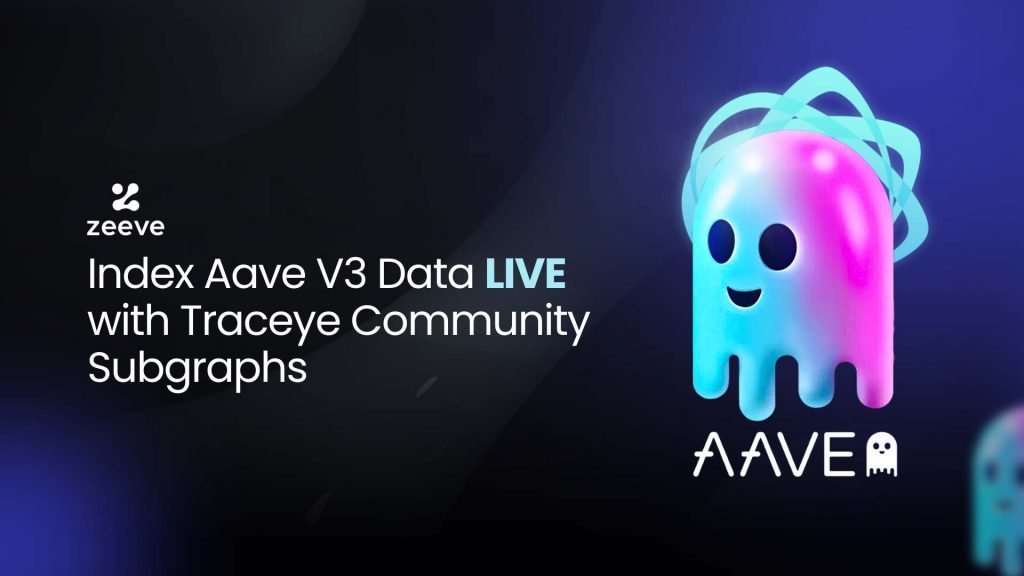Aave V3 is the upgraded, most recent version of the Aave Protocol– the decentralized and non-custodial liquidity market for seamless borrowing and lending of crypto assets. Besides allowing suppliers to earn interest on their liquidity and borrowers to borrow assets, Aave V3 has a significant role in enabling developers to innovate and build great DeFi applications such as exchanges, flash loan platforms, yield aggregators, asset management apps, and more. Hence, these app developers need both historical and live data from the Aave V3 protocol based on their specific project requirements.
With this article, we continue our data indexing series with Traceye’s community subgraphs. We have previously covered UniswapV3 and Compound V3, and now, let’s discuss indexing Aave V3 live data. With Traceye’s community subgraphs, you can query data from indexed databases quickly through GraphQL APIs running in the backend.
Brief Overview of Traceye’s Aave V3 Subgraph
The Aave V3 subgraph is yet another indexed, shared subgraph offered by Traceye. The subgraph is available for one-click activation under Traceye’s community subgraphs, and hence, developers and data consumers can query live Aave V3 data using it. For example, market hourly/daily snapshots, real-time interest rates, market lists, and so on.
Aave V3 subgraphs as community subgraphs are automated, which means all the essential subgraph components, like GraphQL schema, ABI files, and manifests, are already deployed and running in the backend. Users don’t need to do any heavy lifting on their end. All they need is the basic knowledge of Subgraphs and GraphQL entities.
Who all may need Aave V3 Protocol’s live data?
Below are some of the main use cases that heavily rely on Aave V3 live data:
Trading platforms: Enterprises or developers building trading platforms will need to leverage Aave V3 live data and insights to ensure better execution of lending, borrowing, and exchange strategies in their ecosystem. For example, a trading app might need real-time reserve data, user data, deposit data, flash loan data, and lending/borrowing data from Aave V3.
Applications integrating Aave V3’s functionality: DeFi applications may need to integrate Aave V3’s functionality in their app to make it more useful and interactive. For this, they need data such as interest rates, available liquidity, and real-time borrowing trends, which can help developers create more robust and user-friendly interfaces for their applications.
Smart contract developers: Developers building smart contracts to interact with the Aave V3 protocol will need live data to enable various functions within the contract. For example, a smart contract designed for a decentralized lending platform will need Aave data to define loan eligibility, calculate current interest rates, and manage collateral.
How to Index Aave V3 Data LIVE with Traceye Community Subgraphs?
Traceye community subgraphs are designed to eliminate the complexities around data indexing and querying using Aave V3 subgraphs. Instead of building your subgraph from scratch and then maintaining its performance, community subgraphs from Traceye enable one-click deployment of hosted Aave V3 subgraphs, thereby providing an easy-to-use interface to pull relevant data via GraphQL queries.
However, Traceye also allows you to launch your dedicated subgraph easily. If you choose this, you first need to create your subgraph, compile it, and launch it on a highly optimized, enterprise-grade infrastructure for availability & performance. Want more information on this? Check out our dedicated article linked below: How to deploy Subgraphs with Traceye? Step-by-Step Guide
Now, let’s walk through the step-by-step Aave V3 subgraph indexing process by leveraging Traceye’s community subgraph offering.
Step 1: Sign up or log in to the Zeeve Platform. On the comprehensive dashboard, navigate to the ‘Traceye’ located on the left panel.
Step 2: Click ‘Hosted Subgraph,’ select the number of community subgraphs, and then proceed to checkout with the ‘Buy Now’ option. Complete the payment process and again navigate to the hosted subgraphs.
Step 3: Click on ‘Add Subgraph’. From the drop-down menu, choose Launch Community. At this point, you can easily create a new subgraph or update an existing one. However, you need a subscription for the subgraphs. All your subgraphs, whether dedicated or shared, will be hosted on Traceye. Plus, you can monitor them all across a unified dashboard.
Step 4: As you can see, a list of protocols has appeared. All these are available at Traceye for retrieving data. Because our article is focused on Aave V3, let’s continue with this protocol. Click on the ‘Activate’ button, and the subgraph will be deployed instantly.
Upon activation, you will see a dashboard similar to the one below that displays details about your subgraph, such as Sync Status (it will be 100% as community subgraphs are already indexed), total requests, API units consumed, and basic information such as subgraph creation date, network type, etc. What’s important here is the Query URL, which we will discuss in the next step.
Step 5: Your Aave V3 subgraph will now index live data, allowing you to query a range of data right away. To pull data, click on the ‘Query URL’ in the above screenshot. You will now be redirected to a GraphQL playground environment designed to allow you to query data and get results from the Aave V3 subgraph.
Step 6: Be it your own subgraph or Traceye’s community subgraphs, they query data based on specific entities that you choose. To see all the entities available with the Aave V3 subgraph at Traceye, click on the GraphQL explorer’s icon. It will unfold a comprehensive list of entities ready to query data. For example, you can see active accounts, events, interest rates, flash loans, etc, in the below image.
Step:7 Let’s say you need live flash loan data for the first 15 IDs. To get this data, click on the ‘flashloans’ entity, enter 15 in the ‘first’ sub-entity, and set an order with ‘account_id. This will indicate the subgraph for Aave V3 subgraph indexing for the first 15 account IDs. Also, there are a bunch of customizations available, like order direction, block, skip, where, etc. We are currently focusing on getting live flash loan data for the first 15 IDs. Hence, we won’t make further customizations. As we have entered all the inputs, let’s proceed to fetch the data.
Click the play button, and flash loan data for all the 15 IDs will appear on the screen. Similarly, you can query data for all your preferred entities.
Monitoring & Logs for Traceye’s community Subgraphs
Traceye offers 24/7 monitoring and management service for all your subgraphs deployed on its infrastructure. Speaking about Aave v3 subgraphs, you can check logs on important parameters; Info, debug, warning, and error. The dashboard will produce specific logs for each parameter, allowing you to get a holistic view of your subgraph’s performance. Additionally, the dashboard will produce real-time alerts during instances like storage running out, potential downtime, or similar performance-related issues. Additionally, you can explore older and newer logs, as required.
Conclusion
Congratulations on successfully deploying an Aave V3 subgraph with Traceye. As you can see, community subgraphs are quick and extremely easy to deploy and query data from. Without writing a single line of code, enduring the complex process of data indexing, or doing configurations, you can start retrieving data from your preferred protocol.
However, as discussed, your requirement is for a dedicated subgraph or building a subgraph from ground level; feel free to contact us. Get more information on Traceye or Zeeve’s blockchain-related services. Send your queries via mail or schedule a call for a detailed discussion.





